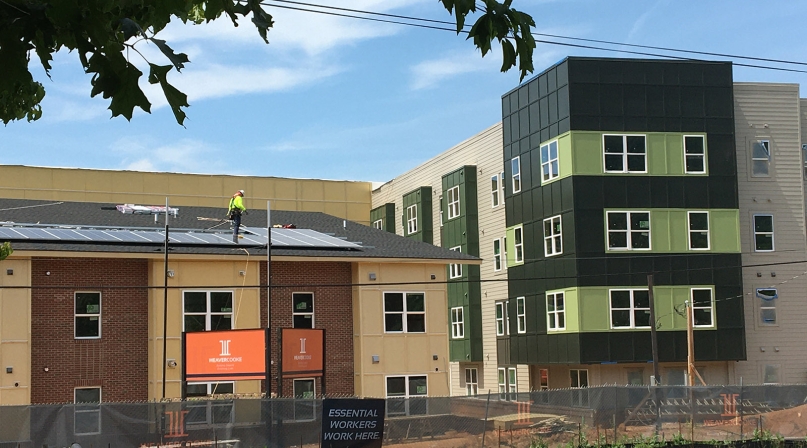Problem:
|
A limited supply of housing, high prices and geographic challenges creates a need and demand for affordable housing.
|
Solution:
|
Create a points-based program to incentivize developers to increase density and create more affordable housing options.
|
There is a menu of options on the table for developers in Buncombe County, N.C. who are looking to create more affordable and workforce housing through the county’s points-based incentive program.
Buncombe County’s Community Oriented Development (COD) program incentivizes density and design flexibility to create affordable housing units, all while adding sustainability features and community amenities. Developers complete a scorecard-like rubric to earn points that lead to density bonuses.
County Planning Director Nathan Pennington said the program was borne out of the need to create more housing options throughout the county.
Learn More
For more information on Buncombe County’s Community Oriented Development Program, contact Planning Director Nathan Pennington.
Buncombe County’s Community Oriented Development is the recipient of a Best in Category 2020 NACo Achievement Award in the Planning category.
Buncombe County, which is home to the City of Asheville, is a popular gateway and tourist destination. The area faces a variety of challenges when it comes to housing such as a limited supply of housing units, high rent, lack of public infrastructure and topographic constraints.
Pennington said the 660 square-mile county has everything from valleys to mountain peaks to rivers and rural areas that lack infrastructure.
“If it’s not part of a steep slope, if it’s not in a floodplain, if it’s not in an area that has soils that are not conducive to development, there’s very limited areas that can be developed that are all in competition for each other,” he said.
The area has seen steady growth and demand over the years with many people coming to the county to leave more urban areas. U.S. News and World Report recently ranked Asheville the eighth best place to retire.
With the many different agencies competing for a small amount of land and the increased demand from residents, Pennington said the county needed to incentivize the creation of units.
The COD program launched in 2015 as an element allowed by a countywide zoning ordinance.
Buncombe County Planning and Development staff designed the program to provide developers with greater flexibility in site design and housing types.
The program allows for the clustering of buildings, creation of useful open spaces and encourages constructions near designated transportation corridors, employment centers or available public water and sewer.
The program awards density bonuses up to 250 percent for developers who meet different criteria based on the density table rubric. Through the program, developments must set requirements for income eligibility and affordability rates for a minimum of 15 years.
“It’s very much a program that pushes really good, high-quality design and it balances out the more expensive nature of that by incentivizing the density. I think it strikes a good balance,” Pennington said.
Bonuses are awarded based on three categories: Community, environment/transit and economy with additional points available in the “added amenities” categories.
Examples include accessibility features, wetland conservation, Energy Star certification, community facilities like playgrounds and sidewalks, among others.
“To get the higher amounts of density, you’re given a menu of options to choose from that represent good project design,” Pennington said.
Buncombe County has approved two COD projects that are already in the works and have a few others in the pipeline.
The first project, East Haven Development, is nearly completed and is a 95-unit tax credit development by a local housing non-profit organization. The units will remain affordable for a 30-year period. The project earned density bonuses through the COD program and was able to add 57 additional units.
The second project is a 255-unit apartment and townhome community which earned a 143 percent density bonus, equating to an additional 73 units. Thirty percent of units will be offered at workforce housing rates for a minimum of 15 years.
Buncombe County’s COD program is just another step to solve affordable housing challenges. Other efforts by the county have included zoning ordinances to allow residents to have up to two homes on a property and the Affordable Housing Services Program to provide funding assistance.
Pennington advises other counties to go slow when creating a similar COD incentive program and understand that each community may have its own unique challenges with differing needs.
“I think that a community that looks at our program and says ‘we can do that too,’ just make sure it’s customized to your own jurisdiction,” he said. “Make sure you understand that some of the successes here may not work for you.”




